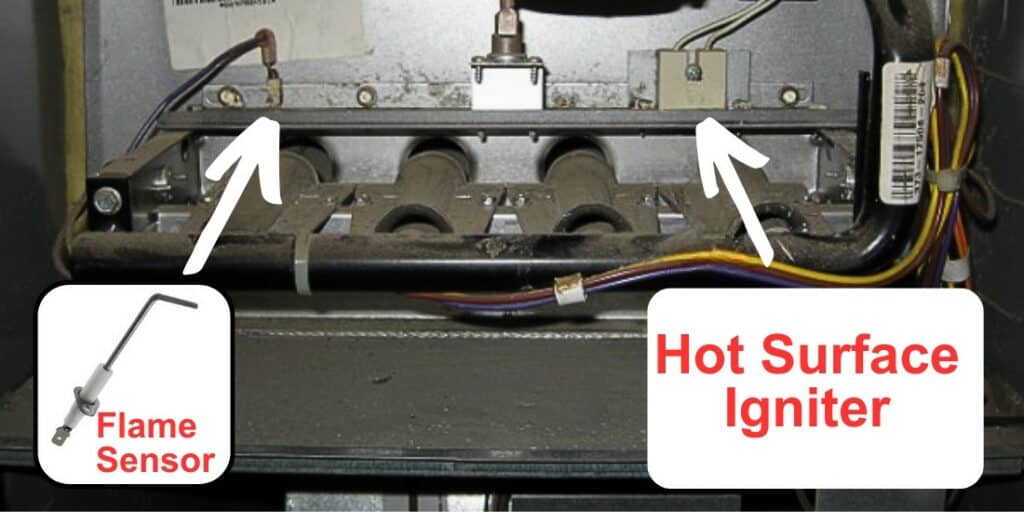Are you tired of costly HVAC technician visits? Well, today’s your lucky day! We’re peeling back the curtain on one of the most straightforward yet essential DIY maintenance tips for your Trane furnace – cleaning the flame sensor.
Yup, this tiny component can throw a big wrench in your cozy evening plans if it gets too grimy. If your home suddenly feels like the inside of a fridge, it might be time to look at your furnace’s flame sensor. But hold on—don’t get it mixed up with the igniter! They serve very different roles. Remember, the flame sensor usually sports a single wire, unlike the igniter, which has two. Got it? Great!

Once you’ve zeroed in on the flame sensor, proceed with caution and treat it with care, especially touching only its porcelain part to prevent any damage. Now, let’s dive into how to get that little trooper cleaned up and your Trane gas furnace back to toasty operations.
I’m here to walk you through how to clean the Trane furnace flame sensor.
DIY Trane Furnace Flame Sensor Cleaning
Before you do anything else, cut the power. We’re dealing with potential sparks and flammable substances here, and safety is not just a suggestion—it’s imperative.
Tools and materials needed:
Though you might hear different advice from seasoned field technicians, it’s wise to stick to what the manufacturers recommend for cleaning – usually steel wool. Handle the Trane furnace flame sensor with the porcelain and use the steel wool to polish the metal rod gently, not scrub it clean.
Arm yourself with the right tools for this mission:
- A trusty screwdriver
- Fine-grit sandpaper or a reliable piece of steel wool
- A soft, clean cloth for wiping away grievances
- A flashlight to shine a light on your endeavors
Step-by-step guide to cleaning the trane flame sensor:
- Finding the Flame Sensor: Open the furnace compartment and locate the sensor near the burners, identifiable by its single wire.
- Gentle Extraction: Unscrew the flame sensor with the care. It’s delicate, and we want no casualties.
- The Cleaning Ritual: Take your sandpaper or steel wool and softly—oh so softly—rub away the gunk.
- Polish to Shine: Once the residue has been banished, use your clean cloth to wipe the sensor, ensuring no dust or dirt is left behind.
- Return to Its Throne: Carefully screw the sensor back into its rightful place.
After you’ve given the rod a thorough but gentle cleaning, it’s time to reinstall the flame sensor, reconnect the wire, and fire up your furnace (power on, of course). If the sensor was the issue, your Trane gas furnace should recognize the flame much faster, rewarding you with warmth and the satisfaction of a job well done.
And if the furnace still throws a fit, it might be time to call in the cavalry (also known as your local HVAC professional).
Signs of a Dirty Furnace Flame Sensor
How do I know if my Trane furnace flame sensor is dirty? A malfunctioning flame sensor in your furnace isn’t just a trivial issue—it’s a full-blown SOS signal from the heart of your heating system. Here’s the inside scoop on recognizing the distress calls:
The Furnace Won’t Turn On
It’s a no-go from the get-go. You expect the warm embrace of heated air when you hit that switch, but if your furnace gives you the cold shoulder and refuses to start, suspect a standoff with the flame sensor. It’s like the sensor is the bouncer at the door of Club Heat, and if it’s not working right, nobody’s getting in.
Short Cycling
Imagine firing up the engine, ready to cruise, but your car stalls every few minutes. That’s short cycling in the furnace world. The heater kicks on, but instead of settling into a cozy rhythm, it shuts off before completing a full heating cycle. This start-stop routine is not just frustrating; it signals a flame sensor that can’t keep the flame verified, and safety protocols dictate a shutdown.
The Click of Uncertainty
Click. Silence. Click. Silence. Suppose you’re hearing this irregular symphony of clicking sounds. In that case, it’s the furnace attempting to ignite and then giving up—a telltale sign that the flame sensor isn’t playing its part in the heating harmony.
Visible Dirt Buildup
When you peer into the furnace’s inner workings, the flame sensor should not look like it’s been through a dust storm. A visible layer of soot or dirt on the sensor is like a barrier, keeping it from detecting the flame accurately. It’s like trying to read a book through a fogged-up window.
Porcelain Problems
Take a gander at the porcelain exterior of the flame sensor. Is there a crack? If so, that’s more than a cosmetic issue—it can affect the sensor’s insulation, which might lead to misreading the flame. Think of it as a crack in the armor, one that could lead to the fall of the furnace’s heating capabilities.
A faulty Trane furnace flame sensor can transform your home from a cozy haven into a chilly cavern. Recognizing these signs is the first step to restoring warmth and ensuring your furnace operates safely and efficiently. Ignoring them could lead to more severe problems, a higher energy bills, and potential safety hazards. Regular maintenance, including a keen eye on these symptoms, can keep the heat flowing and prevent you from being left out in the cold.
What Causes a Dirty Flame Sensor
The flame sensor might just be the most underrated component in the complex ecosystem of your furnace. This modest little part diligently sits in the heat, day in and day out, unbeknownst to many homeowners who might not even realize its existence until it’s too late.
Over time, an almost invisible layer of oxidation and carbon buildup can form on the sensor. It’s like a stealthy ninja, sneaking up unnoticed until the signal between the sensor and the control board is lost in translation. The sensor’s job is to send an all-clear signal about the presence of a flame, and when it can’t do that, it’s like a guard dog sleeping on the job. The result? Your furnace goes into lockdown mode for safety, leaving you in the cold, quite literally.
This buildup can be especially problematic because it’s not always obvious. Unlike a broken fan or a loud noise that demands attention, a dirty flame sensor is silent, biding its time until it’s too late. It’s the hidden culprit, the one element in the shadow causing furnace failure, the unsung villain in the epic saga of household heating.
It’s worth noting that this isn’t just a minor inconvenience. In the heart of winter, a furnace that fails to stay on can lead to uncomfortable and potentially dangerous drops in temperature at home. For those living in areas where the mercury plummets, this isn’t just about battling the cold; it’s a safety concern.
In short, that little flame sensor is the key to a well-functioning furnace, and overlooking its maintenance is like ignoring the oil light on your car’s dashboard. It seems small until you’re stranded on the side of the road—or, in this case, wrapped in blankets, seeing your breath inside your house.
Regular cleaning is a simple remedy to prevent this chaos. It’s a small task with big rewards, ensuring that the heart of your home heating system beats strong, even on the coldest winter nights. So give that flame sensor some TLC, and it will make sure your furnace is more reliable, efficient, and ready to brave the frosty seasons ahead.
Summary
We hope this guide highlights the easy yet impactful task of cleaning your Trane furnace’s flame sensor. With this knowledge, you’re on your way to becoming a DIY maintenance master. Remember, though, it’s always okay to seek professional help if you feel out of your depth.






